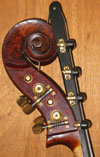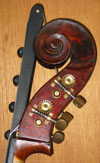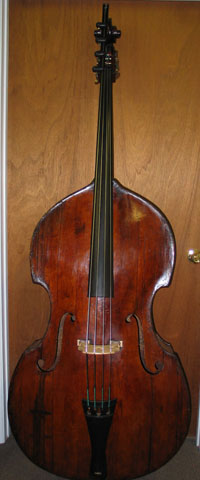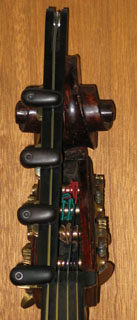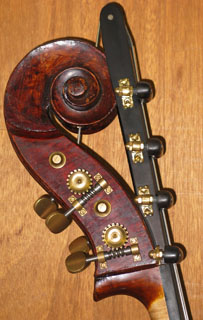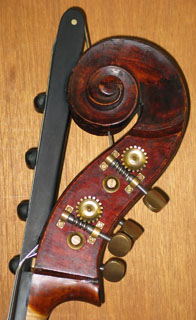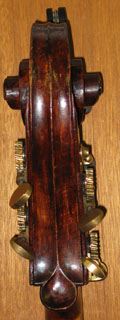| Full Sized English Orchestral Double Bass ~ Flat Back |
| Upper Bout: 21 5/8" (Back, 21 3/4") |
Belly Length: 46 1/4" (modified) (Back, 46 3/4") |
| Center Bout: 15 3/8" |
String Length: 41 7/8" ( modified, reduced from 44") |
| Bottom Bout: 27 1/2" (Back, 28") |
Varnish: Reddish Brown over Gold |
| Rib Depth: 8 3/8" tapering to 5 7/8" at the Neck |
| Top: 2-pc Spruce of extremely fine grain (Purfled) |
| Back & Ribs: 2-pc Highly Flamed quartered Maple (Back: faint inked Purfling lines showing) |
| Neck / Scroll: Maple with flamed Maple Graft (w/ Baker style Gears by Fawcett & Chromatic C-Extension by Bollbach) |
Note: The Scroll was a 3-stringer originally as the plugs from the upper two gears were still visible before the neck graft. This Bass was most likely converted to a 4-string much later, nearer to the start of the 20th century. The Back of the Bass was also repaired sometime in the 19th century and possibly in New England as the 2nd set of Cross Bars were replaced with a single X-Brace without the customary 'lap-joint'. Scars from the original narrow rail-type Cross Braces are still visible and appear to be similar to the old English Gamba making school. A 3-string Maple Tailpiece (stained black with 2 holes added for 4 string) also came with this Bass. This, along with the Yankee style X-brace, hints that this Bass was in use or restored in the USA sometime in the 19th century.
After showing this Bass
to several Bass experts at the 2009 ISB convention, the Mystery still remains. The Italians see Italian in the Bass, the English see English in the Bass and the Germans see some Mittenwald style in the Bass. So, the only School of making that I know of that was influenced by both the Italians and Tirol schools combined are the early English of the 18th and early 19th centuries where both Stainer and Amati were copied followed later by Strad and then Maggini in the Basses. This Bass is definetly nothing to do with the later Maggini idea but we do see a bit of modified Strad in the FFs. Until we see another near exact example of this Bass that is definite of different attribution, the c.1780 English will remain as the overall combined opinion. This Bass has been Sold. |
~ The slow going five year restoration was completed in May 2009 w/C-Extension~ |
